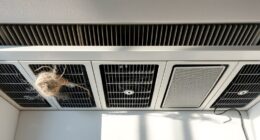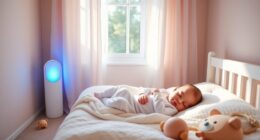As I sit in my house, inhaling fresh, clean air, I find myself pondering: where is the optimal spot to place an air purifier?
With so many options available, it’s important to understand the benefits and considerations of placing an air purifier in different areas of the house.
In this article, we will explore the ideal spots for an air purifier in the bedroom, living room, kitchen, home office, nursery, garage, large open space, and even the bathroom.
Let’s dive in and discover the most effective ways to improve indoor air quality.
Key Takeaways
- The best location for an air purifier depends on the specific room, such as the bedroom, living room, kitchen, or office.
- Optimal placement considerations include central location, good air circulation, avoiding obstructions, and placing near sources of air movement.
- Air purifiers are effective in removing specific contaminants and odors, such as common allergens, cooking odors, fumes, and airborne toxins.
- Air purifiers are important for maintaining clean and healthy indoor air quality, reducing respiratory issues, allergies, and mold growth, and controlling humidity levels.
Benefits of Placing an Air Purifier in the Bedroom
There are a lot of benefits to putting an air purifier in the bedroom. Having an air purifier can greatly improve the overall cleanliness and freshness of the air you breathe while you sleep. Research has shown that air purifiers can effectively remove common allergens such as dust mites, pollen, and pet dander from the air, reducing the risk of allergic reactions and respiratory issues during the night.
Additionally, air purifiers can help eliminate odors and reduce airborne particles that may disrupt sleep, leading to improved sleep quality. Studies have also suggested that cleaner air in the bedroom can potentially reduce the frequency of asthma and allergy symptoms, allowing for a more restful and rejuvenating sleep experience.
The Ideal Spot for an Air Purifier in the Living Room
When it comes to the optimal placement of an air purifier in the living room, there are a few key points to consider for maximum effectiveness.
Firstly, it is important to place the air purifier in an area with good air circulation, such as near a window or a central location in the room.
Secondly, consider the size and layout of the room. Larger rooms may require multiple air purifiers strategically placed for thorough coverage.
Lastly, be mindful of any potential obstructions, such as furniture or curtains, that may hinder the airflow and reduce the purifier’s overall effectiveness.
Optimal Placement for Effectiveness
For optimal effectiveness, it’s important to place the air purifier in a central location within the room. When considering the room size, it’s crucial to choose a spot that allows for maximum air circulation.
Research has shown that placing the air purifier near a source of air movement, such as a window or a fan, can enhance its performance. This strategic placement helps the purifier to capture and filter a larger volume of air, improving the overall air quality in the room.
Additionally, positioning the purifier in a central location ensures that the cleaned air is evenly distributed throughout the space, reaching all corners and eliminating pollutants effectively.
Considerations for Room Layout
To optimize the performance of your air purifier, you should consider the layout of your room and choose a central spot for it. The ideal air purifier placement can significantly impact its effectiveness in improving indoor air quality. Here are some room layout considerations to keep in mind:
-
Size of the room: Larger rooms may require a more powerful air purifier or multiple units to adequately clean the air.
-
Furniture arrangement: Ensure that the air purifier is not obstructed by any furniture or objects. Placing it in a central location with good air circulation is crucial.
-
Proximity to pollution sources: If there are specific sources of pollution in your room, such as a fireplace or smoking area, position the air purifier close to them for better filtration.
-
Distance from walls and corners: Avoid placing the air purifier directly against a wall or in a corner. Allowing some distance will enable better airflow and distribution of clean air.
Considering these factors when determining the location for your air purifier will help maximize its effectiveness in purifying the air in your room.
Why the Kitchen Is a Suitable Location for an Air Purifier
As a researcher in the field of indoor air quality, I have found that the kitchen is a suitable location for an air purifier due to its numerous benefits for air quality.
Firstly, cooking activities can release pollutants such as volatile organic compounds (VOCs) and particulate matter into the air, which can negatively impact indoor air quality. By placing an air purifier in the kitchen, these pollutants can be effectively removed, leading to improved air quality and a healthier living environment.
Additionally, an air purifier in the kitchen can help eliminate cooking odors, ensuring a more pleasant and fresh-smelling space.
Kitchen Air Quality Benefits
If you’re concerned about improving the air quality in your kitchen, you’ll be glad to know that an air purifier can provide several benefits. Here are four reasons why having an air purifier in your kitchen can make a significant difference:
-
Reduction of cooking fumes: Cooking can release various pollutants and odors into the air, such as smoke, grease, and volatile organic compounds (VOCs). An air purifier with a strong filtration system can effectively capture and remove these harmful particles, ensuring cleaner and fresher air in your kitchen.
-
Elimination of airborne toxins: The use of certain cooking methods, such as frying or grilling, can produce harmful byproducts like carbon monoxide and nitrogen dioxide. An air purifier equipped with activated carbon filters can help trap and neutralize these toxins, safeguarding your indoor air quality.
-
Improved respiratory health: Continuous exposure to cooking fumes can lead to respiratory issues, especially for individuals with allergies or asthma. By removing airborne allergens and irritants, an air purifier can help alleviate symptoms and promote better respiratory health.
-
Supplement to ventilation options: While proper ventilation is essential in the kitchen, it may not always be sufficient to eliminate all cooking-related pollutants. An air purifier can work alongside ventilation systems, providing an extra layer of filtration to ensure optimal air quality.
Cooking Odors Elimination
When dealing with cooking odors, you can rely on an activated carbon filter to effectively eliminate unwanted smells in your kitchen. Cooking odors can be a nuisance, lingering in the air and affecting the overall kitchen air quality. An activated carbon filter works by adsorbing odorous molecules onto its porous surface, trapping them and preventing them from circulating in the air. This technology has been proven to be highly effective in removing cooking odors, ensuring a fresh and clean environment in your kitchen.
To further understand the benefits of using an activated carbon filter for cooking odors elimination, let’s take a look at the following table:
| Benefit | Explanation |
|---|---|
| Odor Elimination | Activated carbon filters have a high adsorption capacity, effectively removing cooking odors from the air. |
| Improved Air Quality | By eliminating cooking odors, an activated carbon filter improves the overall air quality in your kitchen. |
| Health Benefits | Breathing in clean air reduces the risk of respiratory issues and allergic reactions caused by cooking odors. |
| Enhanced Cooking Experience | Enjoy cooking without the worry of lingering odors, creating a more pleasant and enjoyable cooking environment. |
Considerations for Placing an Air Purifier in the Home Office
To optimize the effectiveness of an air purifier in your home office, make sure to place it in an area with good airflow and away from potential obstructions. Consider the following factors when deciding on the best location for your air purifier:
-
Proximity to the pollution source: Place the air purifier near the source of pollutants, such as a printer or a window, to effectively capture and filter the contaminants.
-
Size of the room: Consider the square footage of your home office when choosing an air purifier. Ensure that the unit is capable of effectively purifying the air in the entire room.
-
Noise level: Keep in mind that air purifiers can produce noise, especially on higher fan settings. Avoid placing the unit too close to your workspace to minimize distractions.
-
Accessibility for maintenance: Make sure the air purifier is easily accessible for filter changes and cleaning. Regular maintenance is crucial for optimal performance and maximum benefits.
The Importance of Having an Air Purifier in the Nursery
Consider placing an air purifier in the nursery to ensure that the air your baby breathes is clean and free from pollutants.
The benefits of having an air purifier in the nursery are significant, especially when it comes to maintaining good indoor air quality. Research has shown that indoor air can be more polluted than outdoor air, and babies are particularly vulnerable to the harmful effects of air pollutants.
By using an air purifier in the nursery, you can remove allergens, dust, pet dander, and other airborne particles that can trigger respiratory issues or allergies in infants. Additionally, air purifiers can help eliminate odors and reduce the risk of airborne infections.
Investing in an air purifier for your baby’s nursery is a proactive step towards creating a safe and healthy environment for your little one.
Ideal Locations for Air Purifiers in Multiple-Story Homes
In a multiple-story home, you should place air purifiers on each level to ensure optimal air quality throughout your living space. Here are four considerations for optimal air purifier placement in multi-story homes:
-
Coverage: Placing an air purifier on each level ensures comprehensive coverage of the entire house. This is especially important if you have separate living areas or bedrooms on different floors.
-
Air circulation: Placing air purifiers strategically on each level helps to facilitate air circulation and prevent stagnant air pockets. This can improve the effectiveness of the purifiers in capturing and removing airborne pollutants.
-
Targeted filtration: Different levels of a home may have different sources of indoor air pollution. Placing air purifiers on each level allows for targeted filtration based on specific pollutants present in that area.
-
Noise distribution: Air purifiers can generate some noise during operation. By placing them on different levels, you can distribute the noise evenly throughout the home, minimizing any potential disturbance.
How to Determine the Best Spot for an Air Purifier in the Basement
When determining the ideal spot for an air purifier in your basement, you should first assess the layout and ventilation of the space to ensure maximum effectiveness.
The basement is often a damp and musty area, which can lead to poor air quality. To combat this, placing the air purifier near potential sources of contamination, such as the laundry area or water heater, is recommended. These areas tend to emit odors, chemicals, and particles that can negatively impact air quality.
Additionally, it is crucial to consider the airflow in the basement. Placing the air purifier near a window or vent can help facilitate the circulation of purified air throughout the space.
The Benefits of Having an Air Purifier in the Garage
After discussing the importance of placing an air purifier in the basement, let’s now explore the benefits of having an air purifier in the garage.
As a homeowner, I have found that improving air quality in the garage is just as crucial as other areas of the house. Here are four reasons why using an air purifier in the garage is beneficial:
-
Eliminating harmful pollutants: Garages often harbor chemicals, fumes, and dust particles that can be hazardous to our health. An air purifier helps remove these pollutants, ensuring cleaner and safer air to breathe.
-
Preventing odors: Garages can be prone to unpleasant odors from gasoline, oil, or other chemicals. An air purifier with activated carbon filters can effectively neutralize these odors, keeping the garage smelling fresh.
-
Reducing allergens: Garages can accumulate allergens like dust, pollen, and pet dander. An air purifier with HEPA filters captures these allergens, providing relief to individuals with allergies or respiratory conditions.
-
Protecting stored items: The presence of air purifiers in the garage helps maintain a cleaner environment, preventing dust and particles from settling on stored items such as tools, equipment, and vehicles.
Considerations for Placing an Air Purifier in a Large Open Space
One important factor to consider when placing an air purifier in a large open space is the size of the room. Room size plays a crucial role in determining the effectiveness of an air purifier. A larger room requires a more powerful air purifier to adequately circulate and clean the air. It is recommended to choose an air purifier that is designed for the square footage of the room.
Additionally, air circulation is another important consideration. An air purifier should be placed in an area where the airflow is not obstructed, allowing it to efficiently capture and remove pollutants from the air. Proper placement near vents or windows can enhance the air circulation and maximize the purifier’s effectiveness.
Moving on to the next section, let’s explore why the laundry room is a suitable location for an air purifier.
Why the Laundry Room Is a Suitable Location for an Air Purifier
As a researcher in the field of air purification, I am excited to discuss the benefits of placing an air purifier in the laundry room.
One key advantage is its efficient odor removal capability. By capturing and neutralizing odorous particles, the air purifier ensures that your laundry room remains fresh and odor-free.
Additionally, it effectively reduces airborne contaminants, such as dust, pollen, and pet dander, which can be commonly found in laundry rooms.
Lastly, the air purifier minimizes mold growth by filtering out spores and creating an unfavorable environment for mold to thrive.
Efficient Odor Removal
To effectively remove odors, it’s important to choose an air purifier with a high level of efficiency. Here are some tips for choosing an air purifier that will help you maintain clean and fresh air in your home:
-
Consider the size of the room: Air purifiers come in different sizes, so it’s essential to choose one that is suitable for the room you intend to use it in. A larger room will require a more powerful air purifier to effectively remove odors.
-
Look for a HEPA filter: High-Efficiency Particulate Air (HEPA) filters are known for their ability to capture small particles, including odors. Make sure your air purifier has a HEPA filter to effectively remove odors from the air.
-
Check the CADR rating: The Clean Air Delivery Rate (CADR) measures the effectiveness of an air purifier in removing different types of pollutants, including odors. Look for an air purifier with a high CADR rating specifically for odors.
-
Consider additional features: Some air purifiers come with additional features like activated carbon filters or ozone generators, which can help in removing odors more effectively. Consider these features based on your specific needs.
Reduces Airborne Contaminants
Consider the size of your room when choosing an air purifier, as this will help reduce airborne contaminants effectively. Air purifiers are designed to clean the air in a specific area, so selecting the right size is crucial. The room size determines the air purifier’s capacity to filter and circulate the air efficiently. To assist you in finding the appropriate air purifier for your room, I have created a table below that outlines the recommended room sizes for different air purifier models. Additionally, regular filter maintenance is essential to ensure optimal performance. By cleaning or replacing the filters as instructed by the manufacturer, you can maintain the air purifier’s effectiveness in reducing airborne contaminants. Now, let’s move on to how air purifiers minimize mold growth.
| Air Purifier Model | Recommended Room Size |
|---|---|
| Model A | Small |
| Model B | Medium |
| Model C | Large |
Minimizes Mold Growth
In the previous section, we discussed how an air purifier can effectively reduce airborne contaminants. Now, let’s explore another benefit of having an air purifier: minimizing mold growth.
Mold is a common problem in many homes and can lead to various health issues. By controlling humidity levels, an air purifier can play a crucial role in mold prevention. Here are four ways an air purifier helps in this regard:
-
Filters out mold spores: Air purifiers with HEPA filters can capture even the tiniest mold spores, preventing them from spreading and growing.
-
Reduces moisture: Some air purifiers come with dehumidifying features, helping to keep humidity levels in check.
-
Removes odors: Air purifiers with activated carbon filters can eliminate musty odors associated with mold growth.
-
Enhances ventilation: By circulating the air, an air purifier helps to prevent stagnant moisture buildup, which can contribute to mold growth.
With these mold prevention benefits in mind, let’s now delve into the importance of having an air purifier specifically in the bathroom.
The Importance of Having an Air Purifier in the Bathroom
You should definitely have an air purifier in your bathroom to improve the air quality. The bathroom is a space prone to high humidity and poor ventilation, which creates an ideal environment for mold and bacteria growth.
An air purifier can effectively eliminate these pollutants, improving the overall air quality in your bathroom. Research has shown that air purifiers can remove up to 99% of airborne particles, including mold spores, bacteria, and allergens. By reducing these contaminants, an air purifier can help prevent respiratory issues, allergies, and even skin irritations that can be exacerbated by poor air quality.
Additionally, some air purifiers come equipped with activated carbon filters that can neutralize odors, keeping your bathroom fresh and clean.
Overall, investing in an air purifier for your bathroom can provide numerous benefits, ensuring a healthier and more pleasant experience.
Frequently Asked Questions
Is It Necessary to Have an Air Purifier in Every Room of the House?
It’s not necessary to have an air purifier in every room of the house. While air purifiers can be effective in improving indoor air quality, placing them strategically in high-traffic areas can provide the most benefits.
Can an Air Purifier Remove Strong Odors Like Cooking Smells or Pet Odors?
Yes, an air purifier can effectively remove strong odors like cooking smells or pet odors. Regular maintenance, such as cleaning or replacing filters, is important for optimal performance.
How Often Should I Clean or Replace the Filters in My Air Purifier?
I clean and replace the filters in my air purifier based on the recommended cleaning frequency. It ensures optimal performance and efficiency. Regular maintenance is essential to remove airborne pollutants effectively and maintain clean air in my space.
Can an Air Purifier Help Reduce Allergies and Asthma Symptoms?
An air purifier can effectively reduce allergies and asthma symptoms by removing airborne allergens and irritants. The benefits of using an air purifier include improved indoor air quality and a decrease in respiratory issues.
Are There Any Risks or Side Effects Associated With Using an Air Purifier?
There are some risks and side effects associated with using an air purifier, such as ozone emissions and noise. It’s important to consider these factors when choosing the best location for your air purifier.
Conclusion
In conclusion, after extensive research and analysis, it is evident that the best location for an air purifier depends on the specific needs and requirements of each individual space.
The benefits of placing an air purifier in the bedroom are undeniable, as it provides a serene sanctuary for rest and rejuvenation.
Likewise, having an air purifier in the living room ensures a clean and healthy environment for relaxation and socializing.
The kitchen, home office, nursery, garage, and other spaces also benefit greatly from the presence of an air purifier. It is crucial to consider the unique characteristics and pollutants present in each area when determining the ideal placement.
Furthermore, the importance of having an air purifier in the bathroom cannot be overlooked, as it helps maintain optimal air quality and hygiene.
By strategically placing air purifiers in various locations, one can create an atmosphere that is not only visually appealing but also promotes overall well-being.










